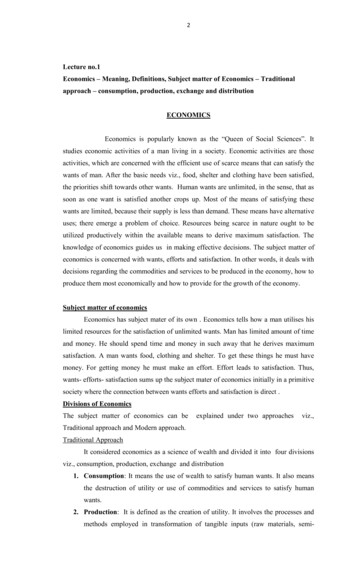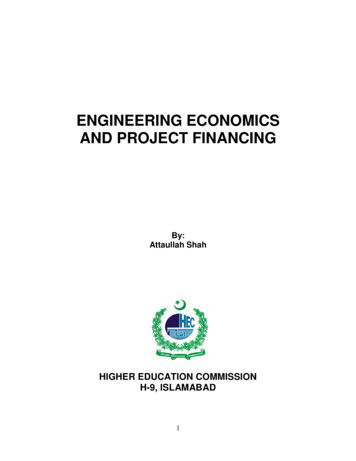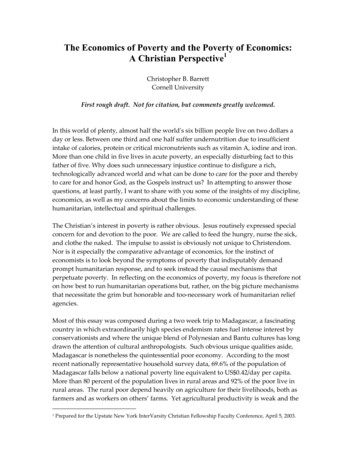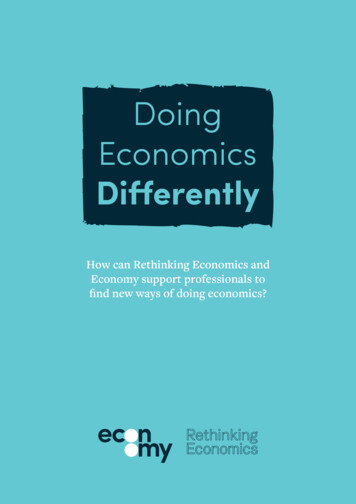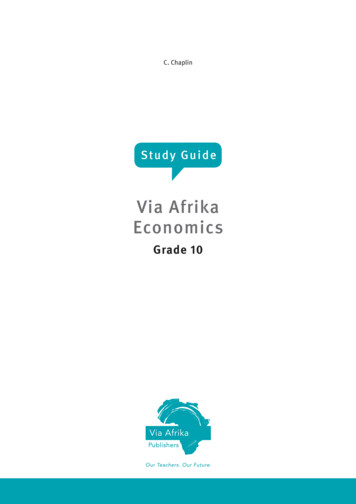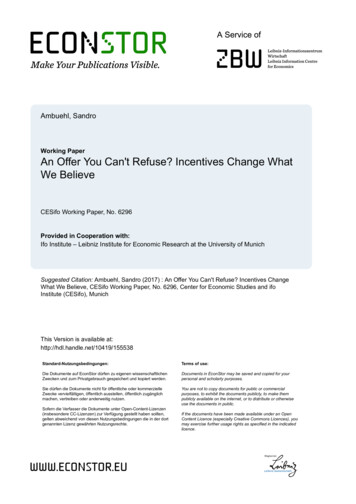
Transcription
Ambuehl, SandroWorking PaperAn Offer You Can't Refuse? Incentives Change WhatWe BelieveCESifo Working Paper, No. 6296Provided in Cooperation with:Ifo Institute – Leibniz Institute for Economic Research at the University of MunichSuggested Citation: Ambuehl, Sandro (2017) : An Offer You Can't Refuse? Incentives ChangeWhat We Believe, CESifo Working Paper, No. 6296, Center for Economic Studies and ifoInstitute (CESifo), MunichThis Version is available ungsbedingungen:Terms of use:Die Dokumente auf EconStor dürfen zu eigenen wissenschaftlichenZwecken und zum Privatgebrauch gespeichert und kopiert werden.Documents in EconStor may be saved and copied for yourpersonal and scholarly purposes.Sie dürfen die Dokumente nicht für öffentliche oder kommerzielleZwecke vervielfältigen, öffentlich ausstellen, öffentlich zugänglichmachen, vertreiben oder anderweitig nutzen.You are not to copy documents for public or commercialpurposes, to exhibit the documents publicly, to make thempublicly available on the internet, or to distribute or otherwiseuse the documents in public.Sofern die Verfasser die Dokumente unter Open-Content-Lizenzen(insbesondere CC-Lizenzen) zur Verfügung gestellt haben sollten,gelten abweichend von diesen Nutzungsbedingungen die in der dortgenannten Lizenz gewährten Nutzungsrechte.If the documents have been made available under an OpenContent Licence (especially Creative Commons Licences), youmay exercise further usage rights as specified in the indicatedlicence.
An Offer You Can’t Refuse?Incentives Change What We BelieveSandro AmbuehlCESIFO WORKING PAPER NO. 6296CATEGORY 13: BEHAVIOURAL ECONOMICSJANUARY 2017An electronic version of the paper may be downloaded from the SSRN website:www.SSRN.com from the RePEc website:www.RePEc.org from the CESifo website:www.CESifo-group.org/wpTISSN 2364-1428T
CESifo Working Paper No. 6296An Offer You Can’t Refuse?Incentives Change What We BelieveAbstractMuch of economics assumes that higher incentives increase participation in a transaction onlybecause they exceed more people’s reservation price. This paper shows theoretically andexperimentally that when information about the consequences is costly, higher incentives alsochange reservation prices to further increase participation. A higher incentive makes peoplegather information in a way that is more favorable to participation—as if they were persuadingthemselves to participate. Hence, incentives change not only what people choose, but also whatthey believe their choices entail. This result informs the debate about laws around the world thatseverely restrict incentives for transactions such as organ donation, surrogate motherhood,human egg donation, and medical trial participation. It helps bridge a gap between economistson the one hand and the policy makers and ethicists on the other.JEL-Codes: D030, D040, D840.Keywords: incentives, repugnant transactions, information acquisition, inattention, experiment.Sandro AmbuehlUTSC Department of Management &Rotman School of ManagementUniversity of Toronto105 St George StreetCanada – Toronto, ON M5S 3E6sandro.ambuehl@utoronto.caOctober 14, 2016This is a throughly revised version of my job market paper I wrote at Stanford University. I am deeply indebted tomy advisors Muriel Niederle, B. Douglas Bernheim, and Alvin E. Roth. I am very grateful to Debra Satz for manydiscussions about philosophers’ work on the ethics of incentives. I am extremely grateful to P.J. Healy and to YanChen for letting me use their experimental economics laboratories. This work benefitted from countless helpfulcomments by seminar audiences at CERGE-EI, the University of Melbourne, the University of Toronto, theWharton School at the University of Pennsylvania, Carnegie Mellon University, the University of California in LosAngeles, the University of Cologne, the University of Munich, Stanford University, as well as at the BehavioralEconomics Annual Meetings, the Congress of the European Economic Association, and the Bay Area Behavioraland Experimental Economics Workshop. I thank Constantine Yannelis for narrating the videos. This work has beenapproved by the Stanford IRB in protocols 29615 (online experiments) and 34001 (laboratory experiments).Funding from the Stanford Department of Economics is gratefully acknowledged.
O ers of large sums of money . . . could lead some prospective participants to enroll . when itmight be against their better judgment and when otherwise they would not do so.- National Bioethics Advisory Commission (2001)Payments to women providing oocytes should be . not so substantial that they . will lead donors todiscount risks. . The higher the payment, the greater the possibility that women will discount risks.- American Society for Reproductive Medicine (2007)1IntroductionMuch of economics assumes that higher incentives increase participation in a transaction only becausethey exceed the reservation price of a larger number of people. This paper shows both experimentallyand theoretically that incentives may also change reservation prices in a way that further increasesparticipation. As incentives rise, people search and interpret information about the transaction di erently. They do so in a way that is more favorable to participation, as if they were trying to persuadethemselves to participate. Thus, incentives do not only change what people choose, but also whatthey believe their choices entail—even before they make a decision.Policy makers and ethicists have long intuited such e ects, and have viewed them as an indicationof deficient decision making (Kanbur, 2004; Satz, 2010; Grant, 2011; Sandel, 2012). This intuition isone major reason behind laws around the world that tightly restrict whether and how transactions suchas organ donation, surrogate motherhood, egg donation, medical trial participation and others can beincentivized. Indeed, worries concern incentives, not the activities per se—altruistic participation isoften applauded.1 The welfare costs of restricting incentives are potentially enormous. For instance,Held et al. (2016) estimate that the ban on incentives for kidney donation is responsible for thepremature death of up to ten thousand Americans on the waiting list each year.2 Hence, whether andhow incentives change the quality of decision making is a critical question.The debate has su ered from the lack of two crucial pieces of information. First, is it true empirically that incentives change what people believe their choice options entail, and do they do so in theway policy makers and ethicists are concerned about? Second, is such behavior really an indicationof unsound decision making, or is it merely an expression of Bayesian rationality? These questionsare of independent interest. If incentives indeed alter people’s beliefs about their choice options, incentives do not merely change choices, but genuinely persuade. Implications then extend to all kindsof situations in which information acquisition and incentives interact, in fields as diverse as finance,marketing, and political economy.1 Satz (2010) explicitly mentions “a paternalistic concern that sellers would actually be harmed by the sale of theirorgans, but that . they would sell their organs if it were legal.”2 The same authors estimate that restrictions on incentives for kidney donation cause taxpayers annual costs of 12billion because current treatments for kidney disease are more expensive than the presumed costs of a donor kidney.1
In this paper I answer both questions, in three parts. First, an experiment demonstrates thathigher incentives cause people to acquire and interpret information about a transaction in a waythat is more favorable to participation. The experiment emphasizes ecological validity, and thus usesan unfamiliar, visceral transaction that is, in select aspects, similar to those for which incentivesare restricted by law. It features two conditions. In the control condition, subjects cannot acquireinformation about the transaction. Hence, incentives increase participation only because they exceedthe reservation price of a larger number of people. In the treatment condition, subjects can gatherinformation, perhaps selectively, after learning the incentive they will be o ered for participating.Hence, incentives may change reservation prices. Indeed, in that condition, as incentives rise, subjectsbecome more interested in encouraging information about the transaction, and less keen to learn aboutthe risks and downsides. Importantly, the supply of people willing to participate in the transactionresponds more strongly to an increase in the incentive amount if endogenous information acquisitionis possible than if it is not. Hence, the change in information demand a ects participation decisions;it does not merely serve to justify a choice subjects would have made anyway. A direct measurementof reservation prices confirms that higher incentives deflate them, ceteris paribus, reflecting changedexpectations about what the transaction entails. Higher incentives cause subjects to successfullypersuade themselves to participate.Second, a model of costly information acquisition shows that this perhaps worrisome-looking behavior is, in principle, entirely consistent with Bayesian rationality. When the consequences of atransaction are uncertain, and information about them is costly, agents will typically decide whetherto participate based on incomplete information. Their choice may be di erent from the one theywould have made under complete information, akin to type I and type II errors in classical statistics.Optimal information demand reflects the costs of these errors. Because an increase in the incentive forparticipation changes these costs, it changes the kind of information the Bayesian demands, as follows.With a higher incentive for participation, type I errors (mistaken participation) are less costly, becausethe additional payment partially insurances against ex post undesirable outcomes. Simultaneously,type II errors (mistaken abstention) are more costly because the opportunity cost of abstention ishigher. In order to better eschew type II errors, and potentially make more type I errors, the information the Bayesian chooses to consult will be more favorable to participation, both in states of theworld in which this is warranted (fewer type II errors) and in those states in which it is not (moretype I errors). Consequently, he will have di erent beliefs about what the transaction entails. Hence,even a Bayesian may look as if he were trying to talk himself into participation. This mechanismapplies whenever the stakes of the decision and the costs of information acquisition are of comparablemagnitude, so it should be expected both in the limited-stakes experiments in this paper, and in moreconsequential decisions in which acquiring encompassing information is comparatively more costly,such as organ donation.33 Toillustrate, most people do not acquire a degree in nephrology before deciding whether to donate a kidney.2
Third, an experiment in a stylized setting conceptually replicates the first experiment, but allowsfor an explicit test of rationality. After all, the mere consistency of a behavioral pattern with Bayesianrationality does not, by itself, imply that humans avoid (non-Bayesian) decision errors. But whetherthey do is a crucial determinant of the welfare e ects of increased incentives.I find that empirical behavior follows the theoretical predictions. Higher incentives make subjectsgather information that is more encouraging, and the same increase in the incentive amount inducesa larger increase in participation when endogenous information acquisition is possible than when it isnot. Importantly, elicited and objective posteriors align closely, even though information is presentedin a fashion that makes it impossible to calculate individual-level posterior beliefs explicitly. Thisindicates a large degree of rationality. But to the extent that people do deviate from rationality, theirbehavior may be concerning to ethicists and policy makers—higher incentives make subjects overlyoptimistic about the consequences of participation.Overall, these results show that incentives do not only change what people choose, but also howthey evaluate their choice options. Because they make people gather and interpret information ina way that is more favorable to the incentivized choice, this behavior may appear worrisome. It is,however, largely consistent with Bayesian rationality, both in theory, and in controlled experiments.The paper contributes to several literatures. It bridges a gap between disciplines by using standardeconomic methodology to inform a concern about the e ects of incentives that is both widely-heldin the applied ethics literature and highly influential in policy.4 It thus contributes to a burgeoningliterature on repugnant transactions that characterizes people’s motives for preventing others fromengaging in voluntary transactions (Kahneman, Knetsch and Thaler, 1986; Basu, 2003, 2007; Roth,2007; Leider and Roth, 2010; Niederle and Roth, 2014; Ambuehl, Niederle and Roth, 2015; Elias,Lacetera and Macis, 2015a,b). In contrast to that literature, the present paper focuses on a specificsuch motive and examines whether its underpinnings stand empirical and theoretical scrutiny.It forges a new connection between a vast literature on motivated reasoning (see Kunda (1990),Klayman (1995), and Epley and Gilovich (2016) for reviews) and formal economic theory. By capturingthe phenomenon in a rational model with standard preferences, it also contributes to work in behavioraleconomics on this topic (see Gino, Norton and Weber (2016); Bénabou (2015); Bénabou and Tirole(2016) for reviews).The paper also contributes to multiple literatures within economics. The mechanism it identifiesis an important comparative static implication of the theory of rational inattention (Sims, 2003, 2006;Woodford, 2012, 2014; Martin, 2014; Caplin and Martin, 2014; Yang, 2014; Matějka and McKay, 2015;Caplin and Dean, 2015; see Caplin (forthcoming) for a review), and the experiment in section 5 isan explicit test thereof. The paper more generally relates to a theoretical literature on endogenousinformation acquisition by Bayesians (Caplin and Leahy, 2001; Bénabou and Tirole, 2002, 2011; Suen,4 By focusing on a single mechanism, this paper cannot take a stance on whether incentives for any particulartransaction such as living organ donation should be limited. The policy implications are more nuanced; they arediscussed in section 6.3
2004; Koszegi, 2006; Eliaz and Spiegler, 2006; Gentzkow and Kamenica, 2011). Like that literature, itrelies on the fact that a Bayesian decision maker whose utility function is non-linear in posterior beliefswill have non-trivial preferences over information structures, and characterizes these preferences.The paper shows that incentives change how subjects acquire and interpret external informationabout a transaction in a way that amplifies their e ect.5 It thus complements a literature thatstudies the inferences subjects draw from the incentive per se (either rationally, as in Kamenica,2008; Cryder et al., 2010; Bénabou and Tirole, 2006, or irrationally, as in the literature on anchoring,Ariely, Loewenstein and Prelec (2003), see Maniadis, Tufano and List (2014) for a review). There,reservation prices typically change in a way that diminishes the e ect of incentives; for instancebecause high incentives may signal that the transaction is unattractive. The first experiment in thispaper shows that people will behave as if trying to persuade themselves when they mostly rely onexternal information about the transaction, whereas they will act in the opposite manner if the mainsource of information about the transaction is the incentive itself.Finally, the paper has applications in fields like finance, political economics, and health economics,in which experts charged with acquiring and interpreting are influenced by incentives, as well as ininformation economics (informational moral hazard), and in marketing (bait and switch). These aredetailed in Section 6.The remainder of this paper proceeds as follows. Section 2 reviews some of the laws and policiesthat restrict incentives for transactions. Section 3 demonstrates empirically that incentives do notonly change what people choose but also what they think their choices entail, in the context of anexperiment that emphasizes ecological validity. Section 4 presents a theoretical analysis of the e ectsof incentives when information acquisition is costly, and shows that, in principle, the results of theexperiment in the preceding section are consistent with Bayesian rationality. Section 5 conceptuallyreplicates the first experiment and tests the extent to which behavior in an experiment in a stylizedsetting conforms to Bayesian rationality. Section 6 discusses policy implications of these findings andapplications to other subfields of economics. Section 7 concludes.2Policies that restrict incentivesWhile this paper identifies a general mechanism, its focal application are the laws and guidelinesthat restrict incentive payments. Here, I review a selection of such laws. They have two thingsin common. First, protecting the person whom incentives would target is an important motivation(amongst others). Second, they are not intended to discourage these activities per se. On the contrary,altruistic participation is often applauded (e.g. Macklin, 1981).5 Bystudying the e ect of increasing incentives on the quality of decision making, this paper also relates to Arielyet al. (2009). While the current paper focuses on the e ects on the acquisition and interpretation of information, thelatter work investigates choking under pressure, which is an altogether di erent mechanism.4
Research participation. The basis of laws on research ethics around the world is the BelmontReport (1978). It states that “undue influence . occurs through an o er of an excessive .reward or other overture in order to obtain compliance.” In similarly vague terms, the NationalBioethics Advisory Commission (2001) fears that “o ers of large sums of money . . . could leadsome prospective participants to enroll in a research study when it might be against their betterjudgment and when otherwise they would not do so.” The concern is that an o er may be “soexcessively desirable that it compromises judgment” (Emanuel, 2004). These regulations applyto both medical and non-medical (e.g. psychological or experimental economic) research. Reproduction. Incentives in the context of reproductive technologies are frequently limited. Afirst example is human egg donation. The majority of countries surveyed by the Council ofEurope in 1998 prevented human egg donation for commercial gain (Council of Europe, 1998).6Protecting donors, who undergo substantial hormonal treatment, is a critical aim. The U.S.permits commercial human egg donation, but the American Society for Reproductive Medicine(2007) recommends that “payments to women providing oocytes should be fair and not sosubstantial that they . lead donors to discount risks” concluding that “sums of 5,000 ormore require justification and sums above 10,000 are not appropriate”.7 A second example issurrogate motherhood. Many U.S. states strictly limit material benefits for surrogate mothers,and partially out of concern for the surrogate mother. Nevada, New Hampshire and Washington,for instance, prohibit payments to surrogate mothers except for particular expenses that areexplicitly listed in the states’ statutes.8 Tissue donation. A prominent current policy debate concerns incentives for kidney donation(Open Letter To President Obama, 2014; Vatican Radio, 2014). Paid living kidney donationis outlawed in every country of the world, except for the Islamic Republic of Iran (Rosenberg,2015b). A frequent argument is that incentives would be coercive (Choi, Gulati and Posner,2014) and that they would distort prospective participants’ assessment of the costs and benefitsof the transaction, possibly to their detriment (Satz, 2010; Grant, 2011; Kanbur, 2004). A relatedexample is bone marrow donation. The World Marrow Donor Association (2011) disapprovesof incentives for bone marrow donation out of concern that “remuneration may . cause theprospective donor to withhold personal health information for fear of being disqualified fromdonation, preventing an accurate risk assessment and disclosure of risks specific to that donor.”6 Ten of these had regulations allowing some reimbursement of expenses. Others outlawed human egg donationsentirely.7 The class action lawsuit Kamakahi v. ASRM challenged these recommendation on antitrust grounds. A recentproposed settlement would require the ASRM to eliminate the explicit price recommendations from these guidelines(Knaub, 2016).8 Legislation varies widely within the U.S. On one extreme, California and Illinois support commercial surrogacy.On the other extreme, Michigan declares any participation in a surrogacy agreement a gross misdemeanor punishablewith jail. This demonstrates how little consensus there is about the ethics of incentives, possibly because of a lack ofinformation about how prospective participants would be a ected.5
Prostitution. There are many views about the e ects of selling sex on those who supply it. Aprominent one maintains that overall, it harms prostitutes, even if they chose to engage in itvoluntarily. This view, amongst others, has been instrumental in laws around the world thatlimit the incentives people can be paid for engaging in sexual activities (Farley, 2013; Danna,2014).Concerns about incentives are particularly prevalent for transactions involving bodily products andparts. But they are neither limited to that domain, nor do they fully encompass it. On the one hand,several laws limit incentives in domains that do not concern bodily products or parts. For instance,the U.S. outlaws selling oneself into voluntary slavery (42 U.S. Code §1994), and “excessive payments”are prohibited also for participants in non-medical experiments. Inducements are outlawed in studentathlete recruiting on account that they would consist “undue influence” (National Collegiate AthleticAssociation, 2015). And the World Council of Churches compels its members not to use materialincentives to induce individuals to change their confession, arguing that incentives would be coerciveand impair religious freedom (Clark, 1996). On the other hand, there are transactions with bodilyproducts for which no comparable laws apply. Many U.S. states, for instance, explicitly excludethe trade with human hair from statutory regulations on trade with bodily products and parts.9Relatedly, no concerns about paying donors of human feces have surfaced, although donors can earnup to 13,000 a year (Feltman, 2015).3Experiment: Do incentives cause self-persuasion?Much of economics assumes that higher incentives increase participation in a transaction only becausethey exceed the reservation price of a larger number of people. However, incentives might also changehow people acquire and interpret information about the transaction. This hypothesis lies behind theconcerns that have led policy makers to restrict incentives for the transactions reviewed in Section 2.In this section, I conduct a laboratory experiment to test this hypothesis. I say that incentives causepeople to self-persuade if they change the distribution of reservation prices in a way that increases thelikelihood of participation.10 The smoking gun is a comparative static on the supply curve. If peopleself-persuade, then the same increase in incentives will have a larger e ect on the supply of peoplewilling to participate in a transaction when they can access information about the transaction afterlearning the incentive than when they cannot.This experiment captures two features of transactions for which incentives are restricted by law,such as living organ donation. First, they are unfamiliar to most prospective participants, and they9 For instance Connecticut, the District of Columbia, Illinois, Michigan, and Texas. Trade in human hair is a multimillion dollar industry (Khaleeli, 2012).10 The term self-persuasion is merely a label for a particular pattern of choices. It might arise both due to entirelyrational reasons (as modeled in section 4, and similar to Bayesian Persuasion in Gentzkow and Kamenica (2011)), ordue to irrational ones (as the term self-deception, that features in the psychology literature, suggests). The extent towhich it reflects irrationality is a crucial determinant of welfare conclusions; see section 6.6
are highly visceral. It is therefore difficult to assess the disutility with participation in monetary terms.Second, they are complex, and thus give prospective participants the opportunity to consult rich andmultifaceted information, perhaps selectively. The transaction in this experiment must, in addition,be legal and reasonably feasible. Hence, in this experiment, subjects decide whether to ingest wholeinsects in exchange for cash payment. Like the motivating transactions, the experimental transactionis also unfamiliar and visceral, and thus hard to assess in monetary terms; and there is multifaceted,rich information about insects as food that laboratory subjects can be presented with. Crucially,insects are produced for human consumption in certified facilities, so that eating them is safe, andinducing people to eat them is legal.11Clearly, insect-eating is di erent from transactions such as organ donation on countless dimensions(examples include altruistic concerns and irreversibility). This experiment does not attempt to replicate these other dimensions, and does not need to. It demonstrates that the attributes it replicatesare sufficient to cause self-persuasion. Consequently, self-persuasion should be expected wheneverthese attributes are present.By examining a setting with genuine preference uncertainty about a real transaction, this experiment emphasizes ecological validity. The cost of this design choice is that distinguishing mechanismsbecomes more challenging. This prevents a definitive assessment of the extent to which the observedbehavior is consistent with rationality. Section 5 therefore presents a complementary experiment thatexamines behavior in a more stylized setting that allows for a precise delineation of mechanisms, andfor a rigorous test of rationality.3.1DesignStructure.The experiment follows a 2 2 across-subjects design. The first dimension varies theincentive amount. A subject is o ered either a 3 or a 30 incentive for eating an insect. The seconddimension varies whether a subject can select and watch one of two videos about insects as food (thevideo and no video conditions, respectively). The no video condition serves a dual purpose. On theone hand, it allows me to study whether endogenous information acquisition changes supply curves.On the other hand, it serves as a control condition that allows me to di erence out any e ects thatpertain to the payment amounts per se.1211 Nonetheless, the transaction is rather intense to most subjects. Some reported that the experiment was “stressful”or that the “insects were scary”, and others refused to even just touch the containers they were packaged in. Evenin countries such as China, Thailand, and Mexico, insect-eating is not practiced by a wide majority. Rather, it isassociated with particular regions and / or communities, and often limited to a small number of insect species. In mydata, Asians and Hispanics are neither more nor less willing to eat insects than Caucasians.12 Payment amounts per se might a ect subjects’ decisions through at least four channels. First, because subjects areinformed of both payment amounts, they might be unhappy to learn that they have been assigned to the 3 condition.Second, eating insects for a lower amount of money may give the subject more bragging rights. Third, a high incentiveamount might crowd out intrinsic motivation to eat insects (Frey and Jegen, 2001). Fourth, incentive amounts mayserve as an anchor for subsequent decisions (Maniadis et al., 2014).7
Briefly, the experiment follows four steps which are described in detail below. First, subjects learnthe incentive amount they will be o ered. Second, they select and watch one of the two videos (inthe video treatment only). Third, they reveal their reservation price for eating insects. Fourth, theydecide whether to eat the insect for the incentive amount o ered in the beginning. Subjects thenparticipate in ancillary treatments. The rules for payment and consumption of insects ensure thatsubjects find it in their interest to reveal their genuine preferences in each decision.Main stages.In the first stage, subjects learn the incentive amount they are assigned to, and thatthey will decide, for each of five food items, whether to eat the item in exchange for that amount.They then learn that all of the food items are whole insects that are either baked, or cooked anddehydrated, and produced for human consumption. Subjects do not make these decisions yet, buttheir behavior in the intervening stages may be a ected by the incentive. Subjects know of bothincentive amounts and that they are randomly assigned to one of them, so that they cannot rationallydraw inferences about the experience of eating insects (although e ects such as anchoring may stillapply).13Only subjects in the video condition participate in the second stage; subjects in the no videocondition proceed directly to the third stage.14 They decide between watching a 6-minute videoentitled “Why you may want to eat insects” (the encouraging video) and one called “Why you maynot want to eat insects” (the discouraging video). Directly afte
billion because current treatments for kidney disease are more expensive than the presumed costs of a donor kidney. 1. In this paper I answer both questions, in three parts. First, an experiment demonstrates that higher incentives cause people to acquire and interpret information about a transaction in a way





